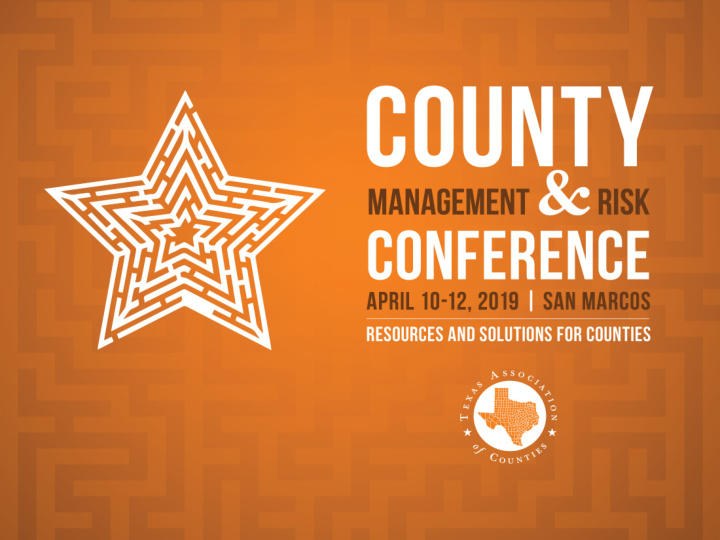



Reducing C Catastr trophic Lo Losses by y Avoid oidin ing the e Path of of L Lea east Resilience Presented by: Rick Whitworth – Sr. Regional Consultant, Young & Associates William Vola, Deputy Coordinator Chambers County Office of Emergency Management Michael Manders, Assistant Auditor Chambers County Robert Ruiz, Associate Director Texas Association of Counties Risk Management Services
Lear arning R g Roadmap • Resilience – what and why? • No Risks, No Way....Know Your Risks and Know the Way • Self-assessment • Funding Sources for Losses • Response in a Catastrophic Event or Loss • FEMA and recovery process • Resources
Risk M k Manag agem emen ent vs. R Resilien ence
No Risk, No Way Know Your Risks, Know the Way
Self Assessment Ready.gov – risk assessment
Ha Have a e a g game e plan an! People Your Plan Your County Coverage Assets Your Department Your Response Your Resilience Operations/Resources
Res esponse se a and nd Rec ecovery • Key Contacts – TAC, emergency vendors, general contractor • Damage Assessment – eyes and ears • Access – who has the keys • Inventory – templates, systematic approach, accountability • Duties and Responsibilities – preservation from further damage
Typ ypes of of Ca Catastrophes Presenter: Rick Whitworth Severe Wildfires Hurricanes Weather – Primarily a – Central (Wind, Hail, Tornadoes) coastal – Northern and Texas phenomenon Western areas of Texas Know the risks in your region!
Why a and h how are t they different? t? • Scale – Number of facilities and magnitude of damage is significant • Personal Property – Sometimes our own homes and businesses are affected, as well as County property. We are pulled in multiple directions at once. • Operational Disruption – Emergency Operations Center, Sheriff’s Department, Courthouse (center of government operations) all may be affected • Increased Regulations - • Emergency Declaration? • Public Procurement Process – Limitations on responsiveness? • FEMA, TAC RMP, TWIA, NFIP Interactions
Whose se Do Dollars Go s Go Firs rst? Yours Insurance/Pool Other Insurance – TWIA, NFIP FEMA Recovery Program Grants
Emer ergen ency Service / e / Mitigati tion W Work v vs. Reconstr truction • Restoration Process Occurs in Phases (Emergency, Mitigation, Reconstruction) • Emergency Response / Mitigation – Specialty contractors with specialized equipment ready to deploy in emergency situations • Safety – Electrical, hazardous materials (asbestos, lead, etc.) • Do you have an asbestos or lead survey on file? For each building? • Mitigate Damages – Drying versus demolition • Who are you going to call? • Local contractor or large, regional firm? • Who will answer in the middle of the night? Or even better…who can you call before the catastrophe occurs? • Reconstruction / Repairs – May not need to be specialty contractor • Could be a separate procurement contract • Existing relationships with vendors prior to catastrophic event
Emergen ency Respon onse / e / Restor oration on P Partner ership • TAC RMP and the County are partners in the process! • TAC RMP has a TEAM of consultants available to help with damage assessment • TAC RMP Property Program Supervisor – Brett Anderson • AS&G Independent Adjuster • YOUNG & Associates Building Consultant • Engineering Consultants (Hygienist, Architectural, Structural, Mechanical, Electrical, etc.) • Contractors (Restoration Contractors and Repair Contractors) – Hired directly by the County • Keep lines of communication open between you and TAC RMP at all times
Di Disaster R r Rec ecover ery Proces cess Presenters: William Vola & Michael Manders Chambers County, Texas 1. It’s all about the PROCESS! 2. The GOLDEN RULE: If you want their GOLD, you will follow their RULES. 3. INFORMATION is KING.
Disaster Recovery Process Essential Pre-Disaster Principles • NIMS Concurrence: Personnel and Operations • Reduce the consequences of disasters through • Mitigation • Preparedness • Planning • Education, training and exercises • Pre-need, standby contracts are the ONLY way! • The more you sweat in training, the less you bleed during response!
Disaster Recovery Process Examples of KEY FEMA Guidance Documents : • FEMA 323 – Public Assistance Applicant’s Handbook • FEMA 325 – Debris Management Guide • FEMA Procurement Guide • FEMA Public Assistance Program and Policy Guide (PAPPG) • 2CFR200 • FEMA Recovery Policies
Disaster Recovery Process Relevant Texas Statutes • Texas Government Code – 262 County Purchasing • Texas Government Code – 418 Emergency Management • Texas Government Code – 2254 Professional Services Contracting • Texas Government Code – 2269 Contracting for Construction • County Purchasing Policies!
Disaster Recovery Process Progression of Recovery Process • Disaster Declaration by Governor, then President • Formal Request for Public Assistance • Recovery Scoping Meeting (Kickoff Mtg) • Exploratory Discussion – Discuss damages & eligibility • Submit Damage Inventory • Creation of Projects in FEMA PA Portal • Documenting progress through submission of documents and processes in FEMA PA Portal • Project Closeouts upon completion & submission of documents
Disaster Recovery Process Key People in the FEMA Disaster Recovery Process • County Judge/Chief Administrative Officer • FEMA Program Delivery Manager (PDMG) • TDEM Grant Coordinator • County Emergency Management • County Purchasing Agent • County Auditor’s Office • Authority Having Jurisdiction (AHJ) over County damaged facilities and equipment TRAINING AND EXPERIENCE MATTERS!!
References and Resources • NOAA National Centers for Environmental Information (NCEI) U.S. Billion-Dollar Weather and Climate Disasters (2019). https://www.ncdc.noaa.gov/billions/ • Ready.gov – “Risk Assessment” Online at https://www.ready.gov/risk-assessment • Property Pool members have access to the following at no additional cost: Property Risk Assessments – contact your Risk Control Consultant Coverage Reviews – contact your Risk Management Consultant • Resource Handbook - packet
Recommend
More recommend